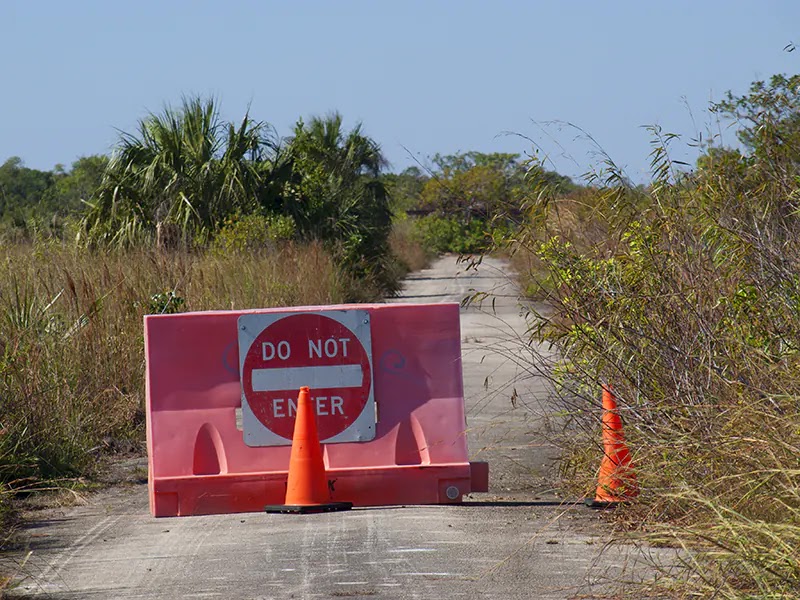We don't know what to do with the many photos we have of Everglades National Park. Too many times walking or biking down there. How Edward Abbey said in Desert Solitaire - this is an affiliate link to Amazon:
A man on foot, on horseback or on a bicycle will see more, feel more, enjoy more in one mile than the motorized tourists can in a hundred miles.
Very true.
Everglades National Park is a remote park and the third largest in the contiguous states after Death Valley
and Yellowstone. There are four places to enter, but they don't connect by road. Each one is a different world. If you need to pick one, go for the Homestead entrance - the main one. You can see more there.
Let's travel in photos through each of these entrances to the park.

|
|
Alligator floating in the waterhole of Royal Palm - License our images here. |
Through the Homestead Entrance
Royal Palm Visitor Center is the easiest place to see wildlife. Its waterhole is a hot destination for the fauna of the Everglades. Gators, fish, grasshoppers, anhinga, and cormorants are the usual dwellers. Once, we also saw a couple of owls.
This area was Paradise Key before becoming Royal Palm State Park in 1916. It has two trails, both very accessible - they are paved. Anhinga goes to the waterhole, while Gumbo Limbo travels through a dry hammock.

|
|
The Royal Park visitor center.
|
The most adventurous can connect from Royal Palm to the old Ingraham Highway, but that is a long hike to nowhere - probably the longest in the national park. If you go, carry some food and plenty of water - more images from this trail in this post.
 |
Hiking on what is left of the old Ingraham Highway.
|
Now a collage of our photos of the waterhole of Royal Palm and some of its dwellers.

|
| The waterhole and the fauna of Royal Palm.
|
Close to Royal Palm is the campground of Long Pine Key. This spot is "high ground" - as high as it can gets on the flatness of the Everglades. The lake is a turquoise beauty. But remember, looks are deceiving. Alligators may be found in any water body of Florida.

|
|
Long Pine Key campground seen from the picnic area.
|
The camp is in a forest of pines plenty with cardinals and crows - check our encounter with a male cardinal in the picnic area of Long Pine Key. The campsites are good, but no electric hookups. The campground is operated by a park concessionaire.

|
|
Campsite of the Long Pine Campground.
|
There are many places to hike around the campground. Most are old forest roads from the times before the national park.
Our favorite is Long Pine Key Nature Trail. From the trailhead, it's 12 miles round-trip to Pine Glades Lake. A short trail continues there around the lake but gets too bushy towards the end. Once, we crossed path with a rattlesnake there.

|
|
Long Pine Key Nature Trail was an old forest road.
|
South of the Long Pine campground is Research Road. Good for the bikes because there is not too much traffic there. This is the route to the HM69 Nike Missile Base historic site.

|
|
Riding our bikes in Research Road.
|
We visited the old military base with our bikes - you can see them on the left corner of the following photo. Interesting small museum about the times when the world we know was pretty close to end.

|
|
Exhibit at the old nuclear base deep in the Everglades. |
By the picnic area of Long Pine Key is the Three-In-One Trail. This short hike travels through three different habitats: rock lands, a tropical hammock, and a marsh - that's why is named "three-in-one".

|
| C in the trailhead of the Three-In-One Trail.
|
The marsh is fine to hike during the dry season. In other months prepare to get wet and muddy. It can become sort of a lake with enough rain.

|
|
The marsh in Long Pine Key. |
By the main road of the park is Pinelands Trail. It's less than a half-mile long and borders a hammock and some solution holes -
this is a photo of one south of Research Road.

|
|
Pinelands Trail is another paved trail.
|
Dwarf Cypress Forest is the shortest trail in the park. It's right on the main road, ten miles from the Lone Pine Key campground. It's just a short boardwalk to a forest of dwarf
cypresses.

|
|
The small and thin dwarf cypresses. |
These cypresses are full-grown trees. They never grew tall because of the shallow waters in this section and the lack of nutrients. They are on high ground for Everglades standards - nearby is Rock Reef Pass, the highest point in the national park at
three feet over sea level.
In winter the dwarf cypresses look lifeless, but with the spring rains their green will return.

|
| There is a small forest underwater near the dwarf cypresses. |
Mahogany Hammock is another easy boardwalk 20 miles from the
entrance of Everglades National Park. It goes through a hammock, a jungle-like island that rises over the wet
flats.

|
|
Entering the Mahogany hammock.
|
Here is the largest living West Indian mahogany of the US. Many strangler figs
grow tall in the hammock. On the ground, nurse logs covered by new life. In
the air, many birds. An island of life and death in perfect equilibrium.

|
|
The forested Mahogany hammock.
|
The marshes around the hammock are full of
periphyton. This is the healthy food of the
Everglades.
West Lake is a few miles before the end of the national park road at Flamingo. There is a boat ramp and a boardwalk there. The boardwalk goes through a forest of mangroves where the three
species grow: red, black, and white.

|
|
West Lake seen from the end of the boardwalk trail.
|
We met a small crocodile on the boat ramp. It disappeared into the dark waters. Good that mom wasn't nearby. West Lake is close to seawater and crocs and alligators share the place.

|
|
The little one was taking its sun bath.
|
In Flamingo there is Eco Pond.

|
| Water is very low in Eco Pond during the dry season. |
A half-mile trail goes around a pond with two bushy islands at the center.
There is no bridge to the islands. Like
everywhere in the Glades, there are big differences in water level between the wet and dry
seasons.
Birds are the main attraction of Eco Pond. Especially if you can survive the mosquitoes early in the morning.

|
|
Wading for food in Eco Pond.
|
Eco Pond is a walk away from the Flamingo Campground. The main road of Everglades National Park ends at the camp entrance. This facility has many loops, but most campsites don't have electric hookups - only one section.

|
|
The coast of Florida Bay and the campground in Flamingo.
|
Flamingo was a fishing village before the national park. It was only reachable by boat. Bird feathers were big business
here. Girly fashion was bad for the birds on those times - get the idea here. Not much is left from the old Flamingo, but there are remains of old docks on the shores of
Florida Bay.
Gud Bradley Trail follows the coast and connects the campground to
the visitor center and the boat ramp - warning: big crocs love to kill time around the ramp.

|
|
Islands in Florida Bay seen from the trail.
|
From the campground, we can also access the longer and more remote Coastal Prairie Trail. This route reaches Clubhouse Beach before going deep
into Cape Sable. It gets flooded during the wet
season.
Other nearby trails are Snake Bight, Rowdy Bend Trail, and
Christian Point. The two first ones allow bicycles. No photos because
we haven't gone.

|
|
Biking the loop road of Shark Valley.
|
Shark Valley: The Tamiami Trail Entrance
This entrance to the national park is close to the Miccosukee Indian Tribe on the Tamiami Trail. It's a loop road that doesn't connect
with the main park entrance west of Homestead, but it gets a few miles deep into the Everglades.

|
|
View towards Homestead from the Shark Valley observation tower.
|
The loop road is 15 miles long. An oil company built it in
1946 and now is traveled by the park tram tours, bicycles, and a few brave hikers who dare to walk the distance. It ends at an observation tower.

|
| The observation tower of Shark Valley. |
There is no shark or valley here. The name comes from the Shark River, a waterway that ends at the Gulf of Mexico. The real danger here is the heat. There is not cover
from the sun in this road. Better to ride the bikes.
We rode twice the Shark Valley Road under the full moon. What an experience to see the Everglades at night.

|
|
Full moon in the Shark Valley tower.
|
Cranes wading through the shallow waters, two snakes swiftly crossing in front
of our bikes, and mysterious red dots on the waters looking us pass - the eyes
of the alligators.
From the tower, we could see the lights of the Miccosukee Indian Tribe eight miles to the north. To the east, the skyline of Miami. A myriad of birds perched on the trees around the waterhole. Impressive nature.

|
| Small alligator at night by the Shark Valley Road.
|
Good memories of ghostly rides through the wilderness of the Everglades.

|
|
The West Coast visitor center, the kayak ramp, and kayaking in the
bay.
|
The West Coast Entrance
The Gulf Coast Visitor Center is on the southern tip of
Everglades City. This is the entrance to Chokoloskee Bay and the
Ten Thousand Islands.

|
| Chokoloskee Bay and the Ten Thousand Islands in the horizon. |
Paddling or boat tours are the way to go here. There are no hiking trails. A kayak trip to
Sand Fly Island is a doable adventure and one can walk there. You need to cross the bay.

|
|
The blocked entrance to the old Grossman Hammock.
|
The lost entrance to Everglades National Park: Chekika
The fourth entrance to the lands of the national park is closer to the city of Miami. This one is the less busy, we can say that it's lost -
check a long post about this forgotten corner of Everglades National Park.
I hope these pictures help on inspiring your trip to Everglades National Park.
Some other posts related to the Everglades that may interest you.

































Comments
Post a Comment